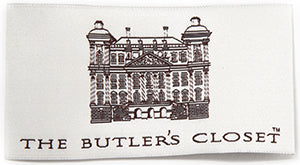A journalist friend visited the extraordinary exhibit “Christian Dior – Couturier du Rêve” at the Musée des Art Décoratifs in Paris in December 2017. She took her her curiosity and her camera to the museum and wrote the piece you can read here. The Denver Museum of Art is hosting an edited version of the exhibition until March 3, 2019, and if you are lucky enough to see it, you will revel in its beauty. Here is the review of the original exhibition in Paris.
A trip through “Christian Dior – Couturier du Rêve” at the Musée des Art Décoratifs in Paris was such an enormous undertaking, one visit did not seem sufficient. It would have been better to drop by several times, focusing on a different aspect of the vast exhibition each visit. You could have started with fabric. Taffeta, organza, mohair, silk ottoman, jet-embroidered faille, satin, chiffon, wool, even simple cotton. And that’s the short list. But it would have been difficult to see the exhibition more than once; on a rainy Friday in early December, visitors without advance purchase tickets (which had sold out weeks before) were told to expect a two-hour wait, and, if returning on the weekend, three to four. Inside, many of the rooms were so crowded that at times it was difficult to move, let alone truly examine the items on display.
Having fun yet?
Yes! It was––past tense because it closed January 7th– arguably the most spectacular costume exhibition ever. A survey of the seventy-year history of Dior, it represented all of the fashion house’s designers through the years, from Christian Dior himself, who founded the company in 1946 and quickly became famous for his “New Look,” followed by Yves Saint Laurent, Marc Bohan, Gianfranco Ferré, John Galliano, Raf Simons, and current creative director, Maria Grazia Chiuri. It was also the largest exhibition ever mounted at the Musée des Art Décoratifs, located at the western end of the Louvre, with more than 300 gowns on display, along with so many photos, accessories, perfume bottles, and art works, the total components must have numbered in the thousands. The rooms of splendid fashions in gorgeous settings went on, and on, and on. And just when you thought you’d come to the end, there would be another room, even more visually arresting than the one before. The ceilings of some of the exhibition spaces soared to the clouds, and the curators took full advantage, stacking dresses all the way to the top. Your jaw dropped as you leaned back to take it all in.
“Couturier du Rêve” started at the beginning, with the early rooms in the exhibition telling the story of Monsieur Dior (1905-1957) and his privileged childhood in Normandy and how it led to fashion design. Art played a major role. In the late 1920s, Dior opened a gallery where he displayed works by artists who, like him, were in the early stages of their journeys toward fame and acclaim, including Alexander Calder, Alberto Giacometti, and Salvador Dali.
After being forced to give up the gallery for financial reasons, Dior became a fashion illustrator, which eventually brought him to design. In a way it was a circular journey, as his interest in art influenced his fashions. Those first rooms in the exhibition contained photos, drawings by Dior himself and such friends as Christian Bérard), portraits of Dior, and art once seen in Dior’s gallery, including a piece by Dali that makes unusual use of a baguette and two ears of corn.
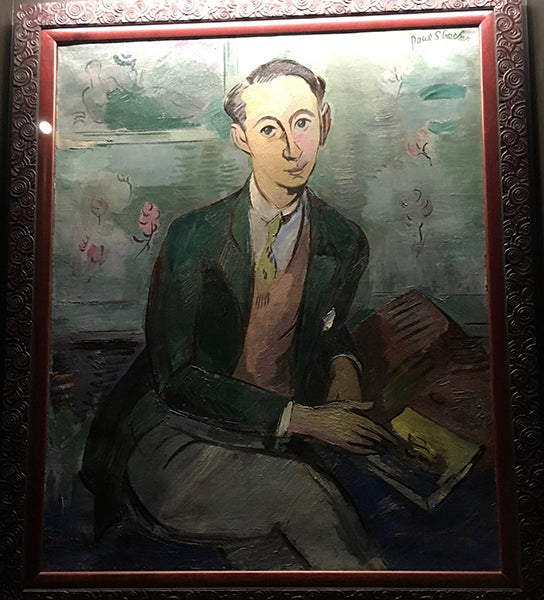

When the House of Dior opened, it happened to be a great time for fashion photography. Iconic photos by Horst, Cecil Beaton, Irving Penn, and Richard Avedon were on display in another early room. Behind a scrim on which a couple of famous pictures, including Avedon’s “Dovima with Elephants,” were projected, the images fading in and out, stood the dresses themselves.
Many of the rooms in Part I of the exhibition had low ceilings, and were the most stuffy and crowded. If I had been inclined to give up and walk further west on the Rue de Rivoli to Angelina’s for hot chocolate, it would have happened here, but I couldn’t leave after seeing “Colorama” – a series of floor-to-ceiling vitrines containing dresses, jewelry, bags, shoes, and exact miniatures of classic designs, all arranged according to the shades of the Dior palette.
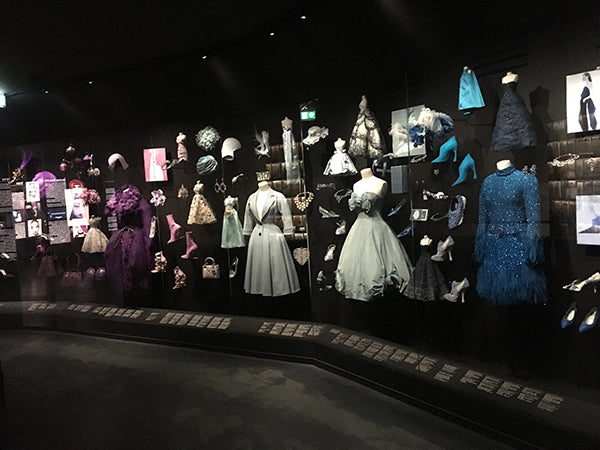

Downstairs, past a wall of vintage magazine covers, the ceilings rose a bit, and out came more dresses, from all of the House of Dior’s designers. The different displays were breath-taking, especially those in “The Dior Gardens.” The older garments were remarkably well preserved, just as daisy-fresh as frocks from recent years. Some visitors were so captivated by it all, they got down on their knees to peer at the intricate detail. But even a simple Dior is a wonder, like a cotton piquédress from 1950.

Along with making waves as a fashion designer, Dior was a leader in the making and marketing of perfume, and space was also devoted to that part of the company’s history, including a screen on which commercials were projected. (If you have never seen Johnny Depp’s ad for “Sauvage,” think: “Eyeliner in the Desert.”)
If the exhibition had ended here, it would have been a satisfying experience, but that was only the first half. After walking back through the lobby, visitors climbed the stairs to Part II.

Each of the designers who followed Dior received his or her own section in this part of the exhibition, though no mention was made of John Galliano being fired in 2011 after he made anti-Semitic remarks.
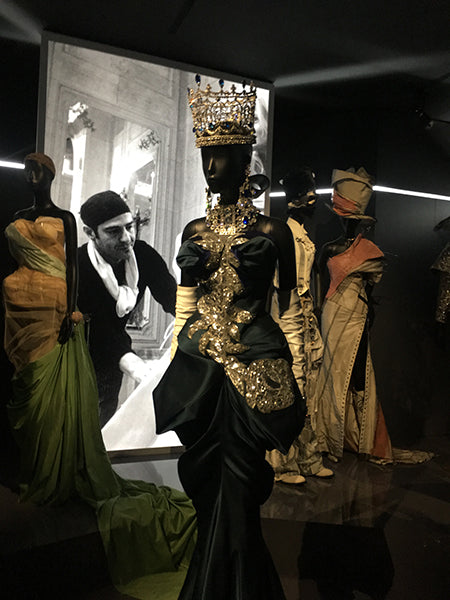
It was in Part II that some of the displays climbed to the ceiling in fashionable strata. One all-white room was stacked with toiles, with a real-live seamstress off to the side, working on an elaborate piece of embroidery as a dozen cell phones recorded the process.

The next section of the exhibition was closer to the ground but just as stunning–– “The Dior Allure,” a string of cascading light boxes, each highlighting an example of a Dior style, including “Trompette,” “Gamin,” “Mazette,” and “Poivron.”
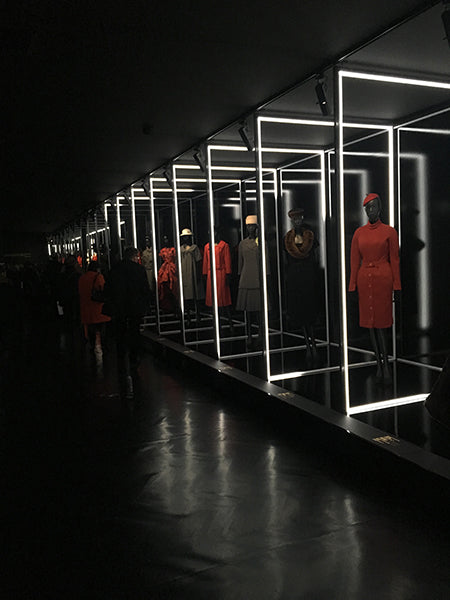
After all that, there was one more spectacular display, “The Dior Ball”––another lofty space filled with dozens of drop-dead gorgeous gowns, many of them made for movie goddesses, from Liz Taylor to Jennifer Lawrence.



Finally, I was Dior-ed out. Which was perfect timing, as the exhibition had come to a close. Reeling from the overload of dresses and images and people, I staggered back to the lobby. The museum would be closing soon.
But as I eyed the exit, I thought: have I really had enough? Spying an opportunity to return to the beginning, where the crowds had been the worst, I slipped back into Part I. There was no one in those early rooms save a couple of guards chiding me to leave. I didn’t have long, but it was a satisfying five-minute solo stroll through the most popular exhibition in Paris, ending at the start, with a red wool dress from Dior's first couture show, in 1947.
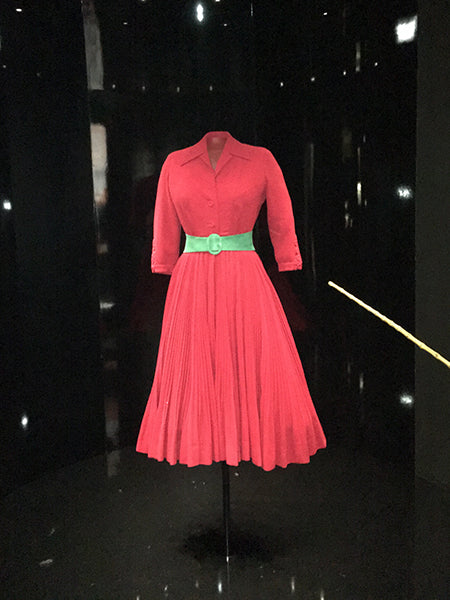
If you missed "Couturier du Rêve" in Paris, do not weep. The exhibition's co-curator, Florence Müller, assembled "Dior: From Paris to the World," for the Denver Art Museum. Though smaller -- 150 dresses as opposed to 300 -- it is spectacular as well. Running from November 18, 2018 through March 3, 2019.
